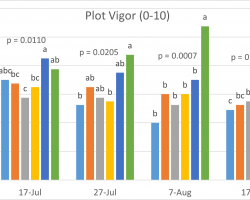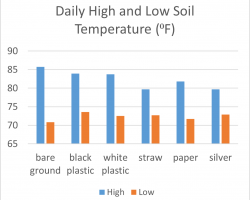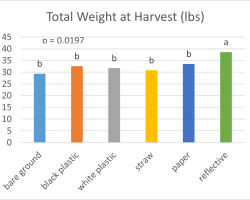Background and Objectives
In previous brassica pest management trials we observed a marked decrease in flea beetle damage in plants grown in certain types of mulches. In these cases, the mulched plants were much more vigorous than those growing on bare ground, and could be identified from across the field for their greater size. This was never the focus of study and so we did not collect data on flea beetle damage at the time,  but decided to investigate this effect in a replicated trial in 2018. We set out to determine:
but decided to investigate this effect in a replicated trial in 2018. We set out to determine:
- if mulches can reduce flea beetle damage to brassica crops,
- if mulches can increase crop quality and/or yield, and
- which mulches are best at reducing damage and increasing quality and yield
Methods
We compared six different mulch treatments, with each treatment replicated four times. We formed raised beds and laid mulches by hand over one line of drip tape. Plastic and paper mulches were secured with soil along the edges. Straw mulch was applied to a depth of 4”. Soil temperature monitors were buried 2” below the soil surface and under the mulch cover.
Four-week old ‘Arcadia’ broccoli seedlings were planted into two rows at 10” between plants and 12” between rows on July 6th. Fertilizer was applied according to soil test results. The plot was irrigated twice in early July but subsequent rainy weather precluded need for further irrigation. On August 3rd, all plants were sprayed with Dipel (1 lb/A) and M-Pede (2% v/v) to control caterpillar pests and aphids.
Each week we rated:
- Flea beetle pressure (# beetles/plant)
- Flea beetle damage, using the following scale: 0=0%; 1=0-10%; 2=11-25%; 3=26-50%; 4=>50%
- Whole plot vigor: a visual assessment of stand, plant size, and leaf color (0-100%)
- Plant height
Once the crop was established (5 weeks) we stopped rating until the crop was ready to harvest and yield data was collected. Because of erratic temperatures and heavy rains, broccoli heads developed very unevenly and we had very few marketable crowns. Therefore, we harvested entire plants by clipping the stem at the soil line and measured the total plant weight per plot, in order to capture the difference in plant growth observed across the mulch treatments.
Results & Discussion
From the very beginning of the trial, we saw significant differences in flea beetle damage across the mulch treatments (Figure 2). The black plastic, paper, and reflective plastic mulches showed consistently less damage than other mulches or the bare ground control, but the reflective plastic mulch stood out as having the least damage of all, and the effect lasted for at least 6 weeks.
All of the mulches improved plant growth relative to the bare ground plants, with straw and reflective silver mulches growing the tallest. Plant height was not directly correlated with flea beetle damage, but rather seems to correspond with soil temperature, which was cooler under these mulches.
Plants grown in reflective mulch were also more vigorous than bare ground plots. For other mulches, no consistent trend is evident; different mulches were more or less vigorous than others at different timepoints.
Mulches influenced both the high and the low temperature of the soil, with the bare ground tending to have the highest high and the lowest low, and mulches acting to modulate the temperature to varying degrees. Soil in the bare ground plots got hottest, followed by black and white plastics, then paper, then straw and reflective silver. During the night, bare ground soil also got colder than mulched plots, followed by paper, then straw and white plastic, then paper, then black and reflective mulch staying warmest. Brassicas are cool-season plants, and prefer a cooler soil and air temperature, so lower soil temperature under straw or reflective mulch could partly explain increased plant growth and vigor observed in those plots.
At the end of the season, we harvested whole plants to assess overall plant growth, since broccoli crowns could not be harvested. Only the reflective silver mulch increased harvest weight, relative to the bare ground control.
Conclusions
Reflective silver mulch contributed to significantly less flea beetle damage and taller and more vigorous plants, and resulted in significantly higher yields. This may be due to cooler soil temperature and more temperature buffering (lower highs and higher lows), or the reflected light may disorient or repel flea beetles, or a combination of factors. The additional cost of the reflective silver mulch ($11/100 row ft compared to $3/100 row ft for black plastic) may be worth the investment, since a significant increase in plant growth and yield was observed. Furthermore, reduced feeding by flea beetles may contribute to reductions in black rot and Alternaria, since flea beetles are known to spread these diseases.
| Harvest weight (lbs) | Cost/100 row ft | |
|---|---|---|
| Bare ground | 29.3 | $0 |
| Black plastic | 32.5 | $3 |
| White plastic | 31.7 | $4 |
| Straw | 30.8 | $30 ($6/bale) |
| Paper | 33.5 | $43 |
| Reflective silver | 38.6 | $11 |
This study was repeated in 2019. Click here to see the 2019 trial report.
This material is based upon work supported by the National Institute of Food and Agriculture, U.S. Department of Agriculture, through the Northeast Sustainable Agriculture Research and Education program under subaward number LNE18-365.





